Information Collection Request for the 2007 Drinking Water Infrastructure Needs Survey and Assessment (DWINSA)
Information Collection Request for the 2007 Drinking Water Infrastructure Needs Survey and Assessment (DWINSA)
2234questionnaire01
Information Collection Request for the 2007 Drinking Water Infrastructure Needs Survey and Assessment (DWINSA)
OMB: 2040-0274

2
OMB No.: XXXX-XXXX
Approval Expires: XX/XX/XX
Federal PWSID No.: XX0000000
Needs Survey and Assessment
U.S. Environmental Protection Agency
Washington, DC 20460
Please verify or correct the following information:
|
Check if Correct as Printed |
Corrected Information (Fill in only if preprinted information is missing or incorrect) |
Name of System (Community): |
|
|
Name of Contact:
Street Address:
City, State, and Zip: |
|
|
Population Served (if seller, include population of systems sold to): |
|
|
Number of Connections (not including those in consecutive systems): |
|
|
Total System Design Capacity: ____________ MGD |
||
Source Water Type (Ground, Surface/GWUDI, etc.): |
Check All That Apply: Ground Surface/GWUDI Purchased Ground Purchased Surface/GWUDI |
|
Ownership Type: |
Check All That Apply: Public Investor-Owned or Federal Government Private Non-Profit |
|
Public reporting burden for this collection of information is estimated to average X hours per response. This estimate includes time for reviewing the instructions, searching existing data sources, gathering and maintaining the data needed, and completing and reviewing the information collected. Burden means the total time, effort, or financial resources expended by person(s) to generate, maintain, retain, or disclose or provide information to or for a Federal Agency. This includes the time needed to review instructions; develop, acquire, install, and utilize technology and systems for the purposes of collecting, validating, and verifying information; adjust the existing ways to comply with any previously applicable instructions; search data sources; complete and review the collection of information; and transmit or otherwise disclose the information. An agency may not conduct or sponsor, and a person is not required to respond to, a collection of information unless it displays a currently valid OMB control number. The OMB control numbers for EPA’s regulations are listed in 40 CFR Part 9 and 48 CFR Chapter 15.
Send comments on the Agency’s need for this information, the accuracy of the provided burden estimates, and any suggested methods for minimizing respondent burden, including through the use of automated collection techniques to the Director, OPPI, Regulatory Information Division, U.S. Environmental Protection Agency (1804A), Ariel Rios Building, 1200 Pennsylvania Ave., NW, Washington, DC 20460; and Office of Information and Regulatory Affairs, Office of Management and Budget, 725 17th Street, N.W., Washington, DC 20503. |
State Use Only State Reviewer: ___________________________________________________________________________________ |
Telephone Number: __________________________ |
I
DRAFT version 8/4/06
Source, Treatment, Storage, and Pumping Inventory
T
Source Projects
are all projects related to collecting and pumping raw water.
This includes wells, surface water intakes, springs, off-stream
raw water storage, pumps, and well houses.
Treatment Projects
are all projects related to disinfection, filtration, or other
treatment processes for ground or surface water sources, or for
treatment applied in the distribution system.
Storage and Pumping
Projects are
related to finished or treated water storage, and booster pump
stations.
o ensure all potential source, treatment, and storage
projects are considered, it may be helpful to complete some or all
of this inventory table. However, completion of this table is not
required.
Source Water |
|||
Inventory |
Needing Replacement |
Needing Rehabilitation |
New Infrastructure Needs |
Total Number and Capacity of Existing Wells or Springs:
|
Wells (including pumps) or Springs:
|
Wells (including pumps) or Springs:
|
Does your system have additional source water capacity needs to meet the needs of current users? (check one) Yes ___ No ___ ______ |
Total Number and Capacity of Existing Surface Water Sources: _____________________________ |
Existing Surface Water Intakes (excluding pumps):
|
Existing Surface Water Intakes (excluding pumps):
|
If yes, how many additional sources are necessary? |
Total Number and Capacity of Existing Pumps:
|
Existing Pumps (but not wells): |
Existing Pumps (but not wells): |
|
Existing Raw Water Pumps: |
Existing Raw Water Pumps: |
||
Treatment |
|||
Inventory |
Needing Replacement |
Needing Expansion/Upgrading or Rehabilitation |
New Infrastructure Needs |
For the sources identified above, enter the number of locations where the following treatment is applied: |
|
||
Disinfection (including booster disinfection): |
Disinfection: |
Disinfection: |
Does your system have additional treatment needs for provision of additional public health protection or for aesthetic concerns? (check one)
Yes ___ No ___ If yes, what additional treatment is necessary? |
Filtration: |
Filtration: |
Filtration: |
|
Chemical removal or addition:
|
Chemical treatment: |
Chemical treatment: |
|
Storage and Pump Stations |
|||
Inventory |
Needing Replacement |
Needing Rehabilitation |
New Infrastructure Needs |
Total Number and Capacity of Existing Storage Tanks:
|
Number of Existing Elevated or Ground-Level Storage Tanks: ________________________ |
Number of Existing Elevated or Ground-Level Storage Tanks: _________________________ |
Does your system have additional storage capacity and/or booster pumping needs to meet the needs of current users? (check one)
Yes No _ If yes, how much additional finished water storage or booster pumping capacity is necessary? |
Total Number and Capacity of Existing Booster Pump Stations:
|
Number of Existing Booster Pump Stations:
________________________ |
Number of Existing Booster Pump Stations:
_________________________ |
|
Source, Treatment, Storage, and Pumping Projects
Project Number |
Project Name |
Type of Need (List 1) |
Reason for Need (List 2) |
New, Replace, Re- Habilitate, Expand |
Current or Future |
Regulation (List 3) (if applicable) |
Design Capacity (MG, MGD, kW) |
Number Needed (if applicable) |
Cost Estimate (if available) |
Date of Cost Estimate (Month/ Year) |
Documen- tation (List 4) |
Ex. 1 |
Replace Wells 3 and 8 |
R1 |
A1 |
R |
C |
4A |
0.5 |
2 |
- |
- |
6, 10 |
Ex. 2 |
Rehab Treatment Plant and Booster Station |
T10 |
A1,A6 |
H |
F |
1A |
5.0 |
1 |
$6,027,000 |
12/05 |
4 |
1000 |
|
|
|
|
|
|
|
|
|
|
|
1001 |
|
|
|
|
|
|
|
|
|
|
|
1002 |
|
|
|
|
|
|
|
|
|
|
|
1003 |
|
|
|
|
|
|
|
|
|
|
|
1004 |
|
|
|
|
|
|
|
|
|
|
|
1005 |
|
|
|
|
|
|
|
|
|
|
|
1006 |
|
|
|
|
|
|
|
|
|
|
|
1007 |
|
|
|
|
|
|
|
|
|
|
|
If you have more source, treatment, storage, or pumping projects check this box and continue on a supplemental sheet (included in this package or downloadable at www.DWNeeds.com). Project numbers for these types of projects are 1000-1999, and should be numbered in sequence.
EPA requires documentation of all projects provided. Applicable types of documentation are presented in List 4 of the Lists of Codes. Use only existing documentation of cost. We do not expect you to develop new cost estimates. |
Transmission and distribution projects are the piping needs of a water system. Projects for valves, hydrants, and meters that are not part of a transmission or distribution project listed in this table should be recorded in the table on page 7. |
On the table below, please provide an estimate of the total feet or miles of pipe in your system, if possible. Completion of this table is not required, but it may be helpful to ensure all potential transmission and distribution pipe projects are considered.
Note: The total feet or miles or pipe in your system is required information if any pipe projects are submitted based solely on survey-generated documentation (documentation codes 10 or 11). |
______________ |
Total feet or miles of pipe in system |
|||||||||||
|
|||||||||||||
|
Total Pipe in System |
|
|
|
<=6 inch |
|
8-12 inch |
|
15-42 inch |
|
>=48 inch |
|
|
PVC |
|
Feet or miles |
|
Amount of PVC by pipe size |
|
feet or miles |
|
feet or miles |
|
feet or miles |
|
feet or miles |
|
|
% of total pipe |
|
% of PVC currently in poor condition or beyond useful life |
|
% |
|
% |
|
% |
|
% |
||
|
|
|
|
|
|
|
|
|
|
|
|
|
|
Ductile Iron |
|
Feet or miles |
|
Amount of ductile iron by pipe size |
|
feet or miles |
|
feet or miles |
|
feet or miles |
|
feet or miles |
|
|
% of total pipe |
|
% of ductile iron currently in poor condition or beyond useful life |
|
% |
|
% |
|
% |
|
% |
||
|
|
|
|
|
|
|
|
|
|
|
|
|
|
Cast Iron |
|
Feet or miles |
|
Amount of cast iron by pipe size |
|
feet or miles |
|
feet or miles |
|
feet or miles |
|
feet or miles |
|
|
% of total pipe |
|
% of cast iron currently in poor condition or beyond useful life |
|
% |
|
% |
|
% |
|
% |
||
|
|
|
|
|
|
|
|
|
|
|
|
|
|
Asbestos Cement |
|
Feet or miles |
|
Amount of asbestos cement by pipe size |
|
feet or miles |
|
feet or miles |
|
feet or miles |
|
feet or miles |
|
|
% of total pipe |
|
% of asbestos cement currently in poor condition or beyond useful life |
|
% |
|
% |
|
% |
|
% |
||
|
|
|
|
|
|
|
|
|
|
|
|
|
|
Other |
|
Feet or miles |
|
Amount of other by pipe size |
|
feet or miles |
|
feet or miles |
|
feet or miles |
|
feet or miles |
|
|
% of total pipe |
|
% of other currently in poor condition or beyond useful life |
|
% |
|
% |
|
% |
|
% |
||
|
|
|
|
|
|
|
|
|
|
|
|
|
|
Transmission and Distribution Projects
Project Number |
Project Name |
Type of Need (List 1) |
Reason for Need (List 2) |
New, Replace, or Re- Habilitate |
Current or Future |
Regulation (List 3) (if applicable) |
Diameter of Pipe (Inches) |
Length of Pipe (Feet) |
Cost Estimate (if available) |
Date of Cost Estimate (Month/Year) |
Documen- tation (List 4) |
Ex. 1 |
Cleaning and Lining Old Cast Iron Mains |
M1 |
A1 |
H |
C |
4A |
12 |
18,000 |
- |
- |
11 |
Ex 2 |
Replace Deteriorated Transmission Main |
X2 |
A1 |
R |
C |
4A |
24 |
20,000 |
$4,200,000 |
06/05 |
1 |
2000 |
|
|
|
|
|
|
|
|
|
|
|
2001 |
|
|
|
|
|
|
|
|
|
|
|
2002 |
|
|
|
|
|
|
|
|
|
|
|
2003 |
|
|
|
|
|
|
|
|
|
|
|
2004 |
|
|
|
|
|
|
|
|
|
|
|
2005 |
|
|
|
|
|
|
|
|
|
|
|
2006 |
|
|
|
|
|
|
|
|
|
|
|
2007 |
|
|
|
|
|
|
|
|
|
|
|
If you have more transmission or distribution projects check this box and continue on a supplemental sheet (included in this package or downloadable at www.DWNeeds.com). Project numbers for transmission or distribution projects are 2000-2999, and should be numbered in sequence.
EPA requires documentation of all projects provided. Applicable types of documentation are presented in List 4 of the Lists of Codes. Use only existing documentation of cost. We do not expect you to develop new cost estimates. |
Backflow Prevention Devices/Assemblies, Hydrants, Service Lines, Valves, Water Meter, and Other Inventory
Although these needs may fit into the other categories of the questionnaire, projects for backflow prevention devices and assemblies, hydrants used to flush water mains, service line replacement, and other items such as valves and meters are recorded in this section to accommodate entries of multiple identical items on one line in the project table.
Record only projects that are not a part of another project (e.g., water main replacement projects will already include valves, hydrants and other appurtenances). |
To ensure all potential projects are considered, it may be helpful to complete some or all of this inventory table. However, completion of this table is not required.
Inventory |
Needing Replacement |
Needing Rehabilitation |
New Infrastructure Needs |
Total Number of Existing Valves (gate, butterfly, PRVs, altitude, etc.):
|
Number of Valves:
|
Number of Valves:
|
Number of Valves:
|
Total Number of Existing Water Meters:
|
Number of Water Meters:
|
Number of Water Meters:
|
Number of Water Meters:
|
Total Number of Existing Hydrants for Flushing Water Mains:
|
Number of Hydrants for Flushing Water Mains:
|
Number of Hydrants for Flushing Water Mains:
|
Number of Hydrants for Flushing Water Mains:
|
Total Number of Lead Service Lines:
|
Number of Lead Service Lines:
|
Number of Lead Service Lines:
|
Number of Lead Service Lines:
|
Total Number of Backflow Prevention Devices/Assemblies:
|
Number of Backflow Prevention Devices/Assemblies:
|
Number of Backflow Prevention Devices/Assemblies:
|
Number of Backflow Prevention Devices/Assemblies:
|
Total Number of Other Items (generators, security components, well houses, computer hardware, etc.):
|
Number of Other Items:
|
Number of Other Items:
|
Number of Other Items:
|
Backflow Prevention Devices/Assemblies, Hydrants, Service Lines, Valves, Water Meter, and Other Projects
Please do not list any component that is included in a pipe replacement or rehabilitation project listed on the Transmission and Distribution Project Table. If you listed any pipe replacement or rehabilitation project without a cost, EPA will assign a cost using a model that includes all these components.
Project Number |
Project Name |
Type of Need (List 1) |
Reason for Need (List 2) |
New, Replace, or Re- Habilitate |
Current or Future |
Regulation (List 3) (if applicable) |
Size (Diameter in Inches) |
Number Needed |
Cost Estimate (if available) |
Date of Cost Estimate (Month/Year) |
Documen- tation (List 4) |
Ex. 1 |
New valves to isolate sections of distribution |
M5 |
A11 |
N |
C |
4A |
12 |
16 |
- |
- |
11 |
Ex. 2 |
Replace Lead Service Lines |
M2 |
A7 |
R |
C |
1D |
- |
100 |
$100,000 |
5/04 |
9, 11 |
3000 |
|
|
|
|
|
|
|
|
|
|
|
3001 |
|
|
|
|
|
|
|
|
|
|
|
3002 |
|
|
|
|
|
|
|
|
|
|
|
3003 |
|
|
|
|
|
|
|
|
|
|
|
3004 |
|
|
|
|
|
|
|
|
|
|
|
3005 |
|
|
|
|
|
|
|
|
|
|
|
If you have more of these types of projects check this box and continue on a supplemental sheet (included in this package or downloadable at www.DWNeeds.com). Project numbers for these types of projects are 3000-3999, and should be numbered in sequence.
EPA requires documentation of all projects provided. Applicable types of documentation are presented in List 4 of the Lists of Codes. Use only existing documentation of cost. We do not expect you to develop new cost estimates. |
Respondent Information
Please provide the following information in case we need to contact you for clarification or additional explanation of any of your responses.
Contact Person (Person who completed this questionnaire):
Signature:
Name (please print):
Title:
Mailing Address:
(Street Address)
Telephone Number:
Fax Number:
E-mail Address:
Best Time to Reach You:
If you have any questions, contact {State Contact} at {State Contact Phone Number} or e-mail to {State Contact E-Mail} or call the U.S. EPA toll-free Needs Survey Helpline at 1‑888‑XXX-XXXX. |
CLOSING: Thank you for your help. Did you remember to:
![]() Attach
all additional project tables to the questionnaire?
Attach
all additional project tables to the questionnaire?
![]() Identify,
by project number, available documentation for all needs and costs
reported above?
Identify,
by project number, available documentation for all needs and costs
reported above?
![]() Put
the questionnaire and the documentation in the pre-paid,
pre-addressed Federal Express Pak provided and return this
questionnaire and the documentation to the address below? (See the
pink enclosure for further return instructions.)
Put
the questionnaire and the documentation in the pre-paid,
pre-addressed Federal Express Pak provided and return this
questionnaire and the documentation to the address below? (See the
pink enclosure for further return instructions.)
Jane Q. Official
Division of Water
State Environmental Department
One Capital Street
Capital, XX 99999
2007 Drinking Water Infrastructure
Needs Survey and Assessment
Instructions
Please take a few minutes to read through these instructions,
the Lists of Codes (blue booklet), and the questionnaire before beginning.
What is the Purpose of the Survey?
The 2007 Drinking Water Infrastructure Needs Survey and Assessment (Assessment) captures the 20-year (January 1, 2007 to December 31, 2026) infrastructure needs of public water systems eligible for Drinking Water State Revolving Fund (DWSRF) monies and reports those needs to Congress. The DWSRF provides low interest loans and other forms of financial assistance to water systems.
The results of this survey document the total national and state-specific infrastructure need for drinking water systems and are used to allocate DWSRF monies to the states for fiscal years 2010 through 2013. Your participation is critical to the success of the survey and to your state’s DWSRF allotment.
What is a “need?”
For the purposes of the
Assessment, a “need” is a project related to
installation or major rehabilitation of capital infrastructure
required now or within the next 20 years to continue to provide safe
drinking water to your consumers. Infrastructure needs are those
that will preserve the physical integrity of the water system and
protect public health.
How Does the Survey Work?
Approximately 3,500 of the 55,000 community water systems across the country have been selected to participate in the survey to report their 20-year need.
The needs of each participating system are extrapolated to represent the total need for each state. State needs are summed to produce an estimate of the national need.
What is My Role?
Your role is to assess your water system’s infrastructure and record projects necessary to meet the needs of current water users over the next 20 years
Each project must be documented or described to show it would address a current or future water quality and/or quantity deficiency. Whenever possible, please use existing documentation such as a capital improvements plan (CIP) or master plan.
If at all possible, please provide any existing project cost estimates. However, do not generate a cost estimate for this survey. If a project does not have a documented cost estimate, please provide design parameters (e.g., length and diameter of pipe needed) so EPA can model the costs.
What am I asked to do?
Read all materials
Identify 20-year project needs
from January 1, 2007 through December 31, 2026
Record projects and identify
documentation
Send completed survey and
documentation to the state by March
2, 2007 or call the
state to make other arrangements.
How Do I Identify Projects to Be Included?
Begin by referring to any planning documents available for your system. Projects listed in your CIP or Master Plan are likely to be allowable needs. You may also refer to the 2003 Needs Survey if your system participated.
Next, review your system inventory and consider projects that may not be included in your planning documents but that you are aware you will need to address within the next 20 years. The inventory tables presented with each project table in the questionnaire are provided to help you identify your needs.
Use “List 1 - Type of Need” in the accompanying Lists of Codes (blue booklet) to help prompt you to consider the types of projects to be included.
Include projects for necessary new infrastructure, or to replace or rehabilitate existing infrastructure, or in the case of a treatment plant, to expand/upgrade the plant.
Current and Future Needs – Include projects that are needed now as well as projects that will be necessary over the next 20 years to address the needs of your existing customer base. However, do not include projects to encourage future growth as discussed in the next section.
Include only one project to address any given piece of infrastructure. For example, if you have a project for the construction of a tank, do not include the subsequent rehabilitation of that tank in 15 years.
Include only projects that have not yet begun construction. If a project has begun construction as of January 1, 2007, do not include it. You may, however, include future phases of a project if it will be built in phases.
W
Current
Need
– projects that are needed now, even if you may not be able to
start immediately due to budget or other issues. Future
Need
– projects that you know will be necessary over the next 20
years, but are not needed immediately (example: a currently
operational storage tank that will require rehabilitation in 15
years). Future
Growth
– projects associated with encouraging growth or based on
speculative growth - these are not allowable.
Projects or costs that are not SRF-eligible:
Projects solely for fire flow, fire protection, or ISA ratings
Projects solely to meet demand of expected future growth or to encourage future expansion or development that are not also necessary to meet the needs of existing customers
Projects for land acquisition not necessary for siting of an infrastructure component (e.g., land purchase to locate a tank would be eligible)
Projects for dams or raw water reservoirs
Projects or costs that are not for capital improvements:
Projects for studies or watershed control programs
Operations and maintenance needs/costs, laboratory analytical costs, or sample collection
Costs associated with staff
Loan interest and fees
Projects that are not associated with public health protection:
Landscaping or other projects for appearance
If documentation implies a project is for one of the above reasons, but you are aware of additional reasons the project is needed, you may provide a signed statement clarifying why the project would address an allowable need.
How is the Questionnaire Organized?
The questionnaire consists of three separate tables on which projects are recorded. The tables address the categories of the type of projects listed below:
Source, Treatment, Finished or Treated Water Storage, and Pumping, Projects.
Transmission and Distribution Projects.
Backflow Prevention Devices/Assemblies, Hydrants, Service Lines, Valves, Water Meters, and Other Projects.
The questionnaire also includes water system inventory tables accompanying each project table. While NOT REQUIRED, completing these tables can help you to consider your system’s entire inventory and assess what parts of your system’s infrastructure may need improvement.
How Do I Provide Project Documentation?
Every project recorded on the questionnaire must be accompanied by documentation that discusses the reason the project is needed. In addition, in order to assign a cost to a project, you must provide either an existing documented cost estimate or sufficient information for the project to be assigned a cost based on cost models.
Documentation Types - See List 4 in the List of Codes for specific types of documentation. The two types of documentation are:
Independent – generated through a process independent of this survey (examples include a CIP, master plan, laboratory results, or bid tabulation).
Some project types require
independent documentation of need (such as a CIP, Master Plan, or
laboratory results):
New
Surface Water Sources
New
Aquifer Storage and Recovery Wells
New
Treatment Plants
Replacement
of an Existing Treatment Plant
Expansion/Upgrade
of an Existing Treatment Plant
Survey-generated – written by you or the state specifically for the purposes of this survey. It must include project details such as age, condition, or associated problems.
Example of Survey-generated
Documentation:
“Project
1006 is for a new well to replace the existing well. The existing
well was drilled in 1957. It has never had any major work done
other than replacing the pump. It has lost production capacity
substantially due to iron build up on the screen. In addition,
subdivision development with on-site septic systems in the area of
the well has compromised the source’s water quality. We need
to replace this well with a new source in the northeast section of
town.”
Documentation of Need
Documentation must provide enough information to indicate that project is for an allowable need. If an independent document is not available or does not specifically address why a project is needed, please provide a signed statement indicating why the project is needed (see example above).
Documentation of need must be less than 4 years old. If you have documentation dated prior to January 1, 2003, please supplement this with a signed statement indicating whether the project is still needed, whether it started construction by January 1, 2007, and if it is still within its original scope.
Documentation of Cost
EPA needs either a cost estimate or enough information to model the cost of each project.
Cost estimates must be from independent documentation such as a CIP, master plan, or bid tabulation. Please indicate the date the estimate was generated, and EPA will adjust for inflation to current year dollars. Do not adjust costs yourself.
Cost estimates must be less than 10 years old (after January 1, 1997).
If there is no independent estimate of cost for a project, simply include the modeling parameters (design capacity in MG or MGD, length and diameter in feet and inches, and number needed) so EPA can estimate the cost.
How Do I Represent a Project on the Questionnaire?
F
How do I submit large pieces of documentation?
If you’re using a large document such as a CIP, you may submit the entire document or make copies of the pertinent pages.
If you choose to send only pertinent pages, be sure to include a copy of the front page with the document title and date.
Please mark up the documentation indicating where each project is discussed. Use tabs, highlighters or simply write the project number in the margin of each applicable page.
Pages 1 and 2 of the Instructions and Lists of Codes booklet have important information about the data collected on the questionnaire.
The questionnaire has examples of projects at the beginning of each table.
Enter a project title and the appropriate codes across each row for each project you have identified.
Document the need for all projects and any cost estimates that are recorded. Identify each piece of documentation by the related project number.
Enclose the necessary documentation for each project with the completed questionnaire.
If you need additional pages for a table, they have been provided. Make copies of blank sheets before beginning.
An electronic version of this
questionnaire package and other materials that may be useful for
completing the questionnaire, such as a complete dictionary of types
of need, are available for downloading at www.DWNeeds.com.
Also, if you have questions,
please call your state's Assessment contact or the toll-free
Assessment Helpline at 1-800-xxx-xxxx. All contact information is
provided on the last page of the questionnaire.
Project Examples and Helpful Hints
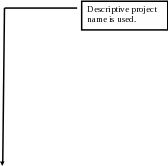
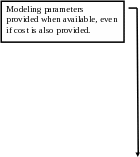
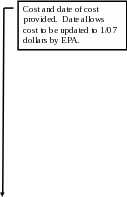
Project Number |
Project Name |
Type of Need (List 1) |
Reason for Need (List 2) |
New, Replace, or Re- Habilitate |
Current or Future |
Regulation (List 3) (if available) |
D |
Length of Pipe (Feet) |
Cost Estimate (if available) |
Date of Cost Estimate (Month/Year) |
Documen- tation (List 4) |
2000 |
Cleaning and Lining Old Cast Iron Mains |
M1 |
A1 |
H |
C |
4A |
12 |
18,000 |
- |
-- |
11 |
2001 |
Replace Deteriorated Transmission Main |
X2 |
A1 |
R |
C |
4A |
24 |
20,000 |
$4,200,000 |
06/05 |
1 |
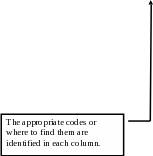
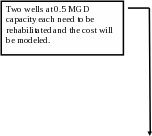
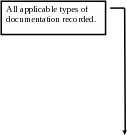

Project Number |
Project Name |
Type of Need (List 1) |
Reason for Need (List 2) |
New, Replace, Expand, Re- Habilitate |
Current or Future |
Regulation (List 3) ( |
Design Capacity (MG, MGD, kW) |
Number Needed (if applicable) |
Cost Estimate (if available) |
Date of Cost Estimate (Month/ Year) |
Documen- tation (List 4) |
1000 |
Rehabilitate Wells 3 and 8 |
R1 |
A1 |
H |
C |
4A |
0.5 |
2 |
-- |
-- |
6, 11 |
1001 |
Rehab Treatment Plant |
T10 |
A1,A7 |
H |
F |
1A |
5.0 |
1 |
$6,027,000 |
12/05 |
2, 10 |
1003 |
New Storage Tank and Pump Station |
S1, P2, W5 |
A4 |
N |
C |
4A |
-- |
-- |
$1,700,000 |
08/04 |
1 |



| File Type | application/msword |
| File Title | 2007 Drinking Water Infrastructure |
| Author | Michelle Young |
| Last Modified By | MDSADM10 |
| File Modified | 2006-09-27 |
| File Created | 2006-09-05 |
© 2025 OMB.report | Privacy Policy
 iameter
of Pipe (Inches )
iameter
of Pipe (Inches ) -
-
 if
available )
if
available )